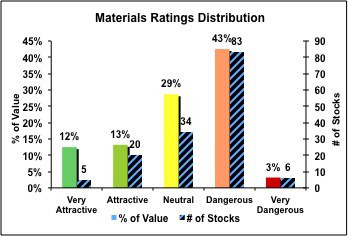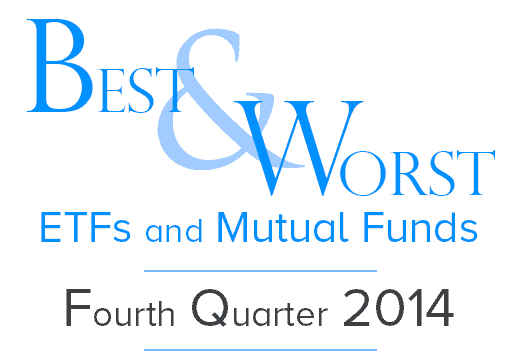We recommend investors avoid all materials sector ETFs. We found no ETFs in the materials sector that offer investors attractive investment merit and acceptable structural integrity. We rate the investment merit of the top-6 materials sector ETFs.
Per our first-quarter-2011 review of U.S. Equity Sector ETFs, the materials sector is one of five sectors that gets our “neutral” rating. Figure 2 shows how the materials sector’s stocks and the market value attributed to them stack up under the microscope of our stock rating system. Unlike other neutral-rated sectors, like the utilities sector, the materials sector has quite a few, twenty-five to be exact, stocks that we rate attractive-or-better. And the sector only has 6 stocks that are ranked “very dangerous”.
Figure 1: Materials Sector – Capital Allocation & Holdings by Risk/Reward Rating

The materials sector has 46% of its value in dangerous-or-worse-rated stocks compared to only 35% of its value in attractive-or-better-rated stocks. Relatively high allocation to dangerous-or-worse-rated stocks causes the materials sector to earn our neutral overall risk/reward rating.
The key takeaway here is that the materials sector offers both good and poor investment opportunities. The investment value of each ETF is derived from its constituents, so ETFs that overweight attractive-or-better-rated stocks are great investment opportunities while ETFs that overweight neutral-or-worse-rated stocks should be avoided.
When analyzing the materials sector ETFs, we started by identifying those ETFs with acceptable structural integrity as measured by XTF, an ETF research firm. We chose the 6 ETFs whose XTF rating was above the sector average XTF rating.
Figure 2: Materials ETFs With Acceptable Structural Integrity

Figure 2 shows clearly that not all materials ETFs are made the same. Different ETFs have meaningfully different numbers of holdings and, therefore, different allocations to holdings. Given the differences in holdings and allocations, these ETFs will likely perform quite differently.
After determining the structural integrity, we analyzed the investment merit of each ETF based on how it allocated value to each stock it held. Figure 3 shows how the 6 materials sector ETFs stack up versus each other and the overall sector based on their overall risk/reward ratings and the allocation of their holdings by rating.
Figure 3: Investment Merit Based on Holdings and Allocations

Attractive ETFs:
We find no Attractive-or-better-rated ETFs.
Neutral ETFs:
PYZ, XLB, VAW, FXZ, and IYM allocate their value in a way that earns a Neutral Overall Risk/Reward rating. Of the 6 ETFs covered in this report, First Trust Materials AlphaDEX Fund (FXZ) is the only ETF whose composition is determined using “Various Fundamentals”. One has to wonder what fundamentals First Trust is using to create an ETF where over 70% of its value is allocated to Neutral-or-worse-rated stocks. We recommend investors buy the Very Attractive and Attractive stocks in this sector before buying any of the Materials ETFs we cover in this report. Contact us for the full list of Materials companies that earn an Attractive-or-better Overall Risk/Reward rating.
Dangerous ETFs:
We recommend investors avoid or short RTM because of its Dangerous Overall Risk/Reward rating. Figure 3 contrasts the difference in investment merit between PYZ, RTM and the overall sector.
Benchmark Comparisons
Sector Benchmark
PYZ and the overall sector have comparable quality-of-earnings ratings. IYE and the sector earn Very Attractive Economic vs. Reported Earnings ratings because their Economic Earnings are positive and rising while Reported Earnings are decreasing. Also, IYE and the sector have identical ROIC’s of 9.6%
PYZ manages to outperform the sector in valuation ratings. PYZ has a Price-to-EBV of 1.3, earning it an Attractive rating, and a GAP of 32 years compared to the overall sector’s Price-to-EBV of 1.7 and GAP of 43 years.
Figure 4: PYZ – Risk/Reward Rating

Figure 5: Materials Sector – Risk/Reward Rating

PYZ more effectively allocates capital than the overall Materials sector. Per Figure 3 above, PYZ allocates 28.7% of its value to Attractive-or-better-rated stocks while the sector only allocates 25.7%. PYZ also allocates 20.6% of its value toward Dangerous-or-worse-rated stocks compared to the sector’s Dangerous-or-worse weightings of 45.5%.
For explanation and details behind our risk/reward rating system, see one of our Company Valuation reports, which are available for free here.
Market Benchmark
The S&P 500 outperforms PYZ in quality of earnings ratings. The S&P 500 and PYZ have the same Economic vs. Reported Earnings ratings but the S&P 500 has an ROIC of 18.3%, earning it a Very Attractive rating, which nearly doubles PYZ’s ROIC of 9.6%.
The S&P 500 and PYZ have comparable valuation rations. Although they have the equal ratings, the S&P 500’s FCF Yield of 2.4% is marginally better than PYZ’s FCF Yield of 2.0%.
Figure 6: PYZ – Risk/Reward Rating

Figure 7: S&P 500 – Risk/Reward Rating

The S&P 500 more effectively allocates capital than PYZ. Per Figure 3 above, PYZ allocates 28.7% of its value to Attractive-or-better-rated stocks while the S&P 500 allocates 42.3%. PYZ also allocates 20.6% of its value toward Dangerous-or-worse-rated stocks compared to the S&P 500’s Dangerous-or-worse weightings of 23.7%.
Methodology
This report offers recommendations on Materials sector ETFs and benchmarks for (1) investors considering buying Materials sector ETFs and for (2) comparing individual ETFs to the Materials sector and the S&P 500. Our analysis is based on aggregating results from our models on each of the companies included in every ETF and the overall sector (148 companies) based on data as of April 19th, 2011. We aggregate results for the ETFs in the same way the ETFs are designed. Our goal is to empower investors to analyze ETFs in the same way they analyze individual stocks.
To make an informed ETF investment, investors must consider:
1) The structural integrity of the ETF and its ability to fulfill its stated objective. We use XTF, an ETF research firm, to find the top 6 ETFs with the best structural integrity rating.
2) The quality of the ETF’s holdings. We determine and ETF’s quality using our overall risk/reward rating system.
Given the success of our Rating system for individual stocks, we believe its application to groups of stocks (i.e. ETFs and funds) helps investors make more informed ETF and mutual fund buying decisions. Barron’s regularly features our unique ETF research. The first article is “The Danger Within”.
